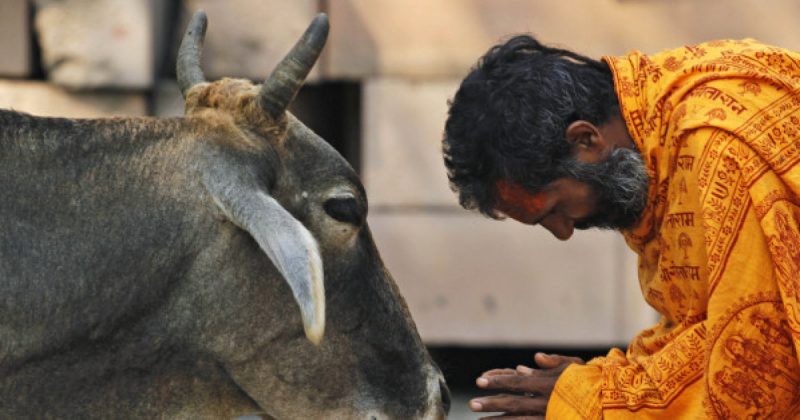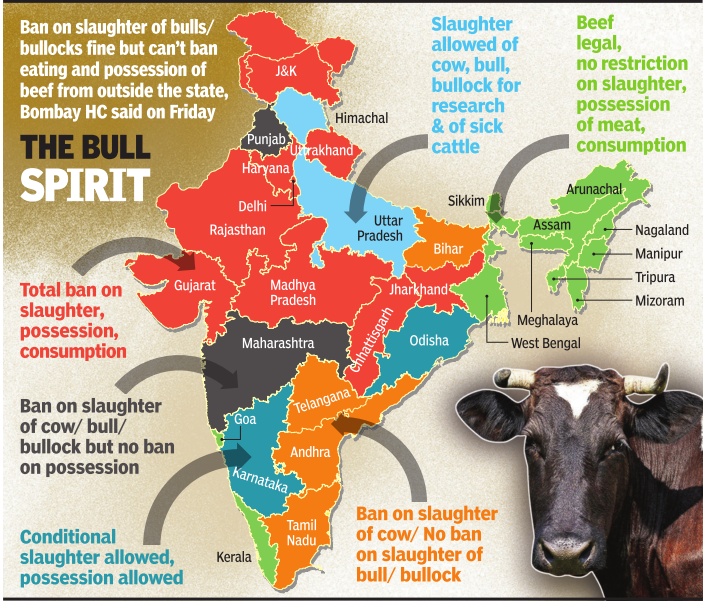Holy Cow!
Posted on November 12, 2018If you have ever been to India, you will know that cows are elemental in the composition of our traffic choked streets. Cars, scooters, motorbikes, cycles, rickshaws and pedestrians all weave through as they amble precariously. Often, a herd will find contentment in sitting in the middle of the road, basking in the sun and curses muttered under commuters’ breaths, while sometimes you shall see them digging their snouts deep into roadside dumpsters. It is not unusual to have seen a cow mechanically lift its tail to attend to nature’s call while walking, neither is it unusual to have stepped in fresh dung. Nevertheless, you may also see men and women feeding them grass (even food from their own freshly prepared meals), worshipping and decorating them, and defending their every right. Polarising as the dialogue around cows is, the fact remains that they are sacred animals for a majority of the Hindu community.
Cows are perceived to be generous and pliant – they give us food (dairy) and fuel (dung and urine). Their altruistic nature is often compared to that of a mother, and thus they are often revered to as Gaumata (Mother Cow). In the oldest Hindu scriptures, the Vedas, the holy cow is juxtaposed with Aditi, the mother of gods [1]. By first century AD, they had attained a status similar to that of a Brahmin, the highest caste in Hinduism. Killing a cow for meat or leather is still a consequential taboo, spawning the beef ban in most states of India [2].

A Hindu holy man worships a cow after bathing in Saryu River in Ayodhya (AP Photo/Rajesh Kumar Singh) | Image Courtesy : HuffPost India
The beef ban enforced by the Ministry of Environment of Indian Central Government led by the Bhartiya Janta Party (BJP) in May 2017 garnered much attention internationally. In a supposed secular country, the ban was a direct attack on several other faiths and cultures. To millions of Indians including Dalits (the lowest caste in Hinduism, the ‘untouchables’), Muslims and Christians, beef is an intrinsic component of the diet, while also being a cheap source of protein. It is now a good time to also take note of the fact that the BJP, the ruling political party in India at the moment, functions heavily under the patronage of the Rashtriya Swayamsebvak Sangh (RSS), an extremist Hindu body [3].
Since the ban, several harrowing incidents illustrate the fascism the BJP pushes through Hindu nationalist propaganda. Men have been beaten, often to death, based on often invalidated claims of animal slaughter, beef storage, and skinning a dead animal [4] . According to IndiaSpend content analysis, 86% of these deaths have been of Muslims, 52% have been based off rumours, and notably, as many as 97% have been reported since PM Modi’s government came into power [5] . Despiteful as these statistics seem, they portray an emergent theme – the false rhetoric of religious intolerance is working, and it is what Indians are reacting to [6] . The manifestation of this ideology can be seen as renaming cities and historic sites has become a priority for the Indian Government. The names of several cities that were derivatives of an Islamic narrative have been changed to ones that have Hindu overtones [7].

Image courtesy : The Times of India
Coming back to cows, in the past few years India has seen a rise in protection laws of the animal. Harsh punishments are doled out to offenders of the Gaumaata and are rigorously followed through. If the judiciary does not punish the accused enough, society does. Ironically, as the safety of cows has gone up, India has become the least safe country for women. Crimes against women have shot up – distressing reports of rape and sexual harassment are a regular feature in the daily newspapers. In 2016, the country saw an appalling 106 rapes a day [8]. However, seldom are laws around sexual harassment as enforced as the ones for cows. The paradox here lies in how the cow is respected as she symbolises The Mother, but a woman is not.
Intrigued by this thought, a 23 year old artist called Sujatro Ghosh started a protest by photographing women wearing a cow mask. A participant named Nicole, said,
“At least if I walk down the streets in a cow mask, my chances of being harassed will probably be slim. No one wants to harass anyone who looks like a deity or a representative of a deity [9].”
Another participant named Suchismita was quoted saying,
In a country with astounding levels of rape, molestation, abuse and other manners of crimes perpetrated against women, it is beyond sick that the matter of cow protection and religion has more traction. What use are protected cows and religious sentiments if half the population of the country needs to live in constant threat in order to facilitate it? These last few years, I’ve realized injecting humour is the only way to tackle these idiots [10].”

Photograph courtesy : Sujatro Ghosh
As depicted by the examples of women, Muslims, Dalits and other minorities, the nationalist movement’s sentiment is not much different from that in several other countries at the moment. While India has Modi, the US has Trump, Brazil has Bolsonaro and the Philippines has Duterte.
In 2014 when Modi was elected to become Prime Minister, it was the first time since 1984 that the BJP had been led into victory by achieving an outright majority [11]. The very fundamentals of the party are Hindutva. Amit Shah, a state minister and Modi’s closest aide, has on several instances given speeches that incite an anti-Muslim sentiment, while also being on trial for murdering three people [12] . But don’t get me wrong, what the BJP is building off of is not a newly birthed attitude, it has been growling in the underbelly of this “secular” land since before Jinnah and Gandhi decided to part ways. Not just cities, but full nations have the ability to store information, and this case, in the form of emotions and beliefs [13] , which aide to the failure of the office being truly inclusive. So how do we strive to be better?
The easiest, apathetic theoretical solution to this would be to flatten any hierarchy between species and take a Chthulucenic approach [14]. In the case that we could actually flatten these hierarchies, we would lose significant information of why and who peoples are and how they act, react and interact. To develop a comprehensive, respectful social environment it is important to take into account these power dynamics, that also may not be in hierarchal form to begin with. Additionally, we must acknowledge the truth of privilege [15], and the truth may not necessarily be stereotyping white people as colonisers. Clearly here, brown Hindus are playing the role of segregating people on the basis of caste, creed, sex and race. As we move towards the future, there no longer is one reality, but it is our task as designers to configure a designed world that represents an inclusive and welcoming community [16].
In the time that I spent writing this blogpost, I have received a change.org petition against changing the name of my city. While I participate in protecting what my city and my culture represent from 7500 miles away, I leave you with the task safeguarding yours – these are difficult times.
– H.M.
[1] : Winston, Kimberly, “The ‘Splainer: What makes the cow sacred to Hindus?”, for the Washington Post, November 2015
[2] : ibid., 1
[3] : Mangaldas, Leeza, “ India’s Got Beef With Beef: What You Need To Know About The Country’s Controversial ‘Beef Ban’,” for Forbes, June 2017
[4] : Barnes, Tom, “ Man beaten to death by mob ‘for killing a cow’ in India,” for the Independent , May 2018
[5] : Abraham, Delna and Rao, Ojaswi, “ 86% killed in cow-related violence since 2010 are Muslin, 97% attacks after Modi govt came to power,” for the Hindustan Times, November 2018
[6] :Haraway, Donna, “ Staying with the Trouble: Making Kin in the Chthulucene,” Duke University Press, September 2016
[7] : Ahmed, Rizwan, “Renaming India: Saffronisation of public spaces,” for Al Jazeera, October 2018
[8] : Chauhan, Neeraj, “ 2016 saw 106 rapes a day, Delhi capital here too,” for The Times of India, December 2017
[9] : Blumbery, Anotonia, “ Women in India Are Wearing Cow Masks To Protest Sexism,” for the Huffpost, June 2017
[10] : ibid., 9
[11] : Chandra, Uday, “Modi’s Hindu nationalism is stumbling,” for Al Jazeera, September 2018
[12] : Johnson, Steven, “Emergence: The Connected Lives of Ants, Brains, Cities, and Software,” Simon and Schuster, 2001
[13] : ibid., 12
[14] : Haraway, Donna, “ Staying with the Trouble: Making Kin in the Chthulucene,” Duke University Press, September 2016
[15] : Oliveira, Pedro, “ Cheat Sheets for a Non- (or Less-) Colonialist Speculative Design,” on Medium, September 2014
[16] : Dunne, Anthony and Raby, Fionna, “ Speculative Everything: Design, Fiction, and Social Dreaming,” MIT Press, December 2013